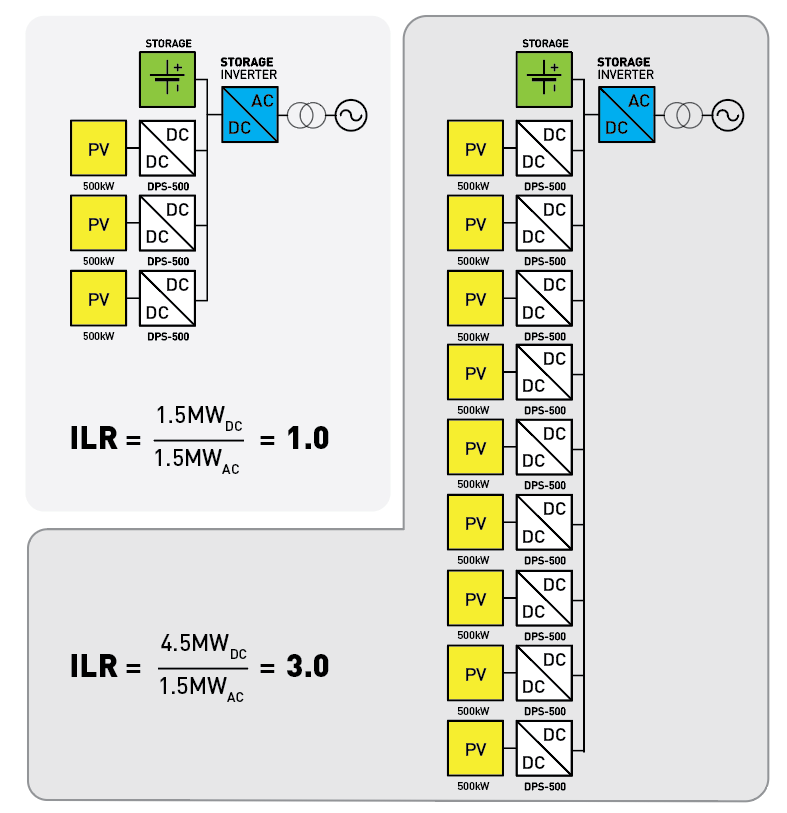In 2018, Dynapower deployed the first DC-DC converter in a DC-coupled PV+S (PV + storage) configuration at an existing utility-scale PV+S installation.
Since then, the innovative solar-plus-storage solution has gained traction due to the ability of DC-coupled PV+S to increase PV energy capture and decrease the costs as compared to AC-coupled energy storage solutions.
Recent reports from IHS Markit and Wood Mackenzie (GTM) forecast DC-Coupled PV+S will be the standard hybrid PV+S topology by 2023 because of its economic advantages over AC-coupled solar plus storage solutions.
Dynapower is currently delivering two DC-coupled PV+S configurations for our customers. Each has specific use case advantages. We work closely with our customers to determine which DC-coupled configuration is best suited for the customer’s application. Here we examine each.
The standard and most common DC-coupled PV +S configuration now being delivered by Dynapower employs a grid-tied PV inverter with energy storage (BESS) coupled to the PV array through a DC/DC converter (Dynapower’s DPS-500). This configuration is often the most economically advantageous approach for DC-coupled PV+S exporting power to the grid.
A second configuration— Reverse DC-Coupled PV+S — now being deployed by Dynapower ties a grid-tied bi-directional energy storage inverter with energy storage directly to the DC bus. PV is coupled to the DC bus through a DC-DC converter (Dynapower’s DPS-500). Reverse DC-coupled PV+S is most often well suited for microgrid application because of its inherent ability to efficiently provide safe and reliable power to an islanded microgrid.

PV inverters are typically unidirectional inverters with firmware intended to operate only in grid-tied conditions and as such cannot support a microgrid alone. The Reverse DC-coupled PV+S configuration, however, allows you to operate in off-grid (microgrid) mode by virtue of the AC interface being a microgrid-capable storage inverter. That is, with a Reverse DC-coupled hybrid PV+S system, you enjoy the CAPEX, efficiency and revenue advantages of DC-coupling while enabling a microgrid application with battery backup power traditionally only possible with an AC-coupled configuration.
Value Add for PV + Storage
In the instance of a microgrid connected to the electric grid and power markets, Reverse DC-Coupled PV+S can also unlock several value streams during times of grid connection.
Grid Charging
PV inverters are designed for unidirectional power flow from the PV array to the grid. While this makes sense for PV only applications, it can become a limitation for PV+S applications. With the Reverse
DC-coupled PV+S configuration, a bidirectional inverter is used for the grid connection, enabling the battery to be both charged and discharged into the grid. This allows a DC-coupled system to take advantage of traditional applications that were once the realm of AC-coupled systems: including frequency regulation, arbitrage and bulk shifting.

Low Voltage Harvest
Due to the PV being coupled to a DC-DC converter in the Reverse DC-Coupled PV+S configuration, the operational low end of the MPPT voltage range can be dramatically lowered. This can expand the ability of the system to operate in low irradiance conditions. Thus the DC-DC converter can effectively harvest energy during the shoulder periods of the solar day and increase the total energy produced by the PV plant.
A Money Saving Solution
Reverse DC-coupled PV+S can also reduce CAPEX costs for hybrid solar plus storage systems.
Inverter Loading Ratios
PV inverters are specified with a max inverter loading ratio, typically on the order of 1.4x the nominal power rating of the PV inverter. The Reverse DC-coupled PV+S configuration can be used to further oversize the PV array relative to the grid tied inverter. This is a desirable feature when a Point of Interconnection (POI) is power limited and the developer wants to time shift as much energy as possible without oversizing the grid tied inverter relative to the POI. DC-DC converters can be used to increase the power rating of the PV array while not needing to increase the power rating of the Inverter.

Easily Expand Your PV
The Reverse DC-coupled PV+S configuration has the added advantage of allowing you to easily add to your PV array in the future. By virtue of the PV being tied in on the DC bus, there is no change to the AC characteristics of your system at the POI when you add to the DC PV capacity. And, because the new PV ties in via new DC-DC converters, there is not a need to re-wire any of your existing strings. In fact, you would be able to install new strings – behind the new converters – at different nominal DC voltages if there were an advantages to doing that, such as using different module/string configurations or a future change in codes allowing higher voltages.
Identifying the Appropriate DC-Coupled Configuration
With over 600MWs of energy storage deployed worldwide, Dynapower understands that each energy storage project is unique. That is why we work alongside our customer partners to determine the appropriate energy storage topology to maximize performance and revenues for each installation.
“Dynapower is unique in that we offer a full complement of AC and DC-coupled energy storage solutions alongside advanced flexible controls,” said Tim Varhue, product manager. “This innovative and modular suite of solutions allows us to partner with our customers be they utilities, solar or microgrid developers to create the best solution possible.”